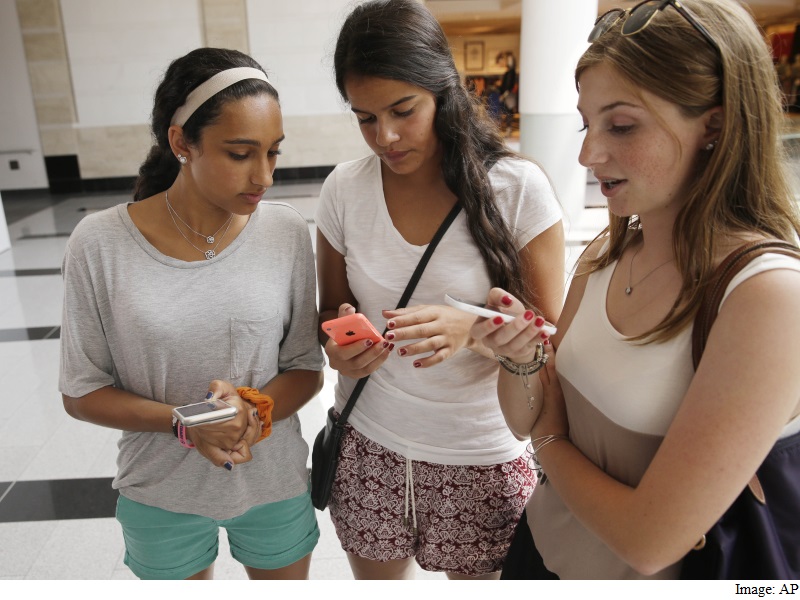- Home
- Mobiles
- Mobiles News
- Smartphones and the Internet Are Eating Our TV Time: Nielsen
Smartphones and the Internet Are Eating Our TV Time: Nielsen

Data provided to The Associated Press show an increase in the number of 18-to-34-year-olds who used a smartphone, tablet or TV-connected device like a streaming box or game console. That grew 26 percent in May compared with a year earlier, to an average of 8.5 million people per minute.
Those devices, which all showed gains in usage, more than offset declines in traditional TV, radio and computers. In the same age group, the demographic most highly coveted by advertisers, use of those devices fell 8 percent over the same period to a combined 16.6 million people per minute.
It's not a one-to-one tradeoff, though. Sometimes people are using smartphones while watching TV, or using them outside the home where it wouldn't cut into TV time. In addition, some mobile device use is, well, to watch TV shows.
Nielsen's inaugural "Comparable Metrics" report for the first time presents data on average use per minute, making it possible to directly compare various devices. The study counts all apps, Web surfing and game play but not texts or calling.
The results confirm a trend in other Nielsen data that found viewing of traditional TV - through a cable or satellite connection or an antenna - peaked in the 2009-10 season.
"It's pretty clear the increased use of mobile devices is having some effect on the system as a whole," said Glenn Enoch, Nielsen's senior vice president of audience insights.
The audience for TV viewing alone fell by 10 percent, to 8.4 million people a minute, in the 18-to-34-year-old category.
The new Nielsen data also looks at time spent watching video on various devices, but not for TV-connected devices, where users were clocked playing games as well.
However, even excluding TV-connected devices, the shift in video watching away from the TV is pronounced.
For the young group, viewing on TVs fell 10 minutes to an average of 5 hours and 43 minutes a day. That's more than compensated for the 33-minute gain in viewing video on computers, smartphones and tablets, which rose to 3 hours and 43 minutes.
Since Nielsen inaugurated its tracking service in 1949, average daily TV viewing has grown steadily, from 4 hours and 35 minutes a day to a peak of 8 hours and 55 minutes in 2009-10. That increase coincided with growing numbers of TV sets sold and the proliferation of programming on cable channels.
But viewership has been declining ever since. From late September until mid-November this year, daily TV watching accounted for only 8 hours and 13 minutes, Nielsen said.
Catch the latest from the Consumer Electronics Show on Gadgets 360, at our CES 2026 hub.
Related Stories
- Samsung Galaxy Unpacked 2025
- ChatGPT
- Redmi Note 14 Pro+
- iPhone 16
- Apple Vision Pro
- Oneplus 12
- OnePlus Nord CE 3 Lite 5G
- iPhone 13
- Xiaomi 14 Pro
- Oppo Find N3
- Tecno Spark Go (2023)
- Realme V30
- Best Phones Under 25000
- Samsung Galaxy S24 Series
- Cryptocurrency
- iQoo 12
- Samsung Galaxy S24 Ultra
- Giottus
- Samsung Galaxy Z Flip 5
- Apple 'Scary Fast'
- Housefull 5
- GoPro Hero 12 Black Review
- Invincible Season 2
- JioGlass
- HD Ready TV
- Laptop Under 50000
- Smartwatch Under 10000
- Latest Mobile Phones
- Compare Phones
- OPPO Reno 15 Pro Max
- Honor Win RT
- Honor Win
- Xiaomi 17 Ultra Leica Edition
- Xiaomi 17 Ultra
- Huawei Nova 15
- Huawei Nova 15 Pro
- Huawei Nova 15 Ultra
- Asus ProArt P16
- MacBook Pro 14-inch (M5, 2025)
- OPPO Pad Air 5
- Huawei MatePad 11.5 (2026)
- Xiaomi Watch 5
- Huawei Watch 10th Anniversary Edition
- Acerpure Nitro Z Series 100-inch QLED TV
- Samsung 43 Inch LED Ultra HD (4K) Smart TV (UA43UE81AFULXL)
- Asus ROG Ally
- Nintendo Switch Lite
- Haier 1.6 Ton 5 Star Inverter Split AC (HSU19G-MZAID5BN-INV)
- Haier 1.6 Ton 5 Star Inverter Split AC (HSU19G-MZAIM5BN-INV)

















